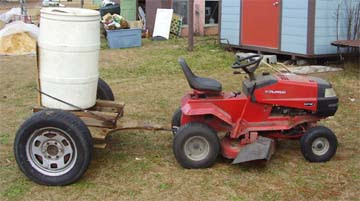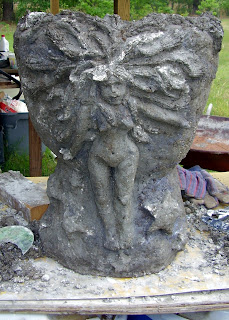a low rent papercrete mixer
 This is a sort of low-rent papercrete mixer that does well for small volumes and might do ever better if I pulled it with my truck instead of my lawn mower. I actually tried it with the truck the first time I used it, but the truck is old and can't take the wear and tear--all that stopping and starting and rolling along at one or two miles per hour--so I just felt more comfortable pulling the mixer around with the lawn mower.
This is a sort of low-rent papercrete mixer that does well for small volumes and might do ever better if I pulled it with my truck instead of my lawn mower. I actually tried it with the truck the first time I used it, but the truck is old and can't take the wear and tear--all that stopping and starting and rolling along at one or two miles per hour--so I just felt more comfortable pulling the mixer around with the lawn mower. I call it low rent because, while most tow mixers involve some welding, this one is made primarily of a piece of fairly thick treated plywood I happened to have laying about from an earlier project.
Plywood was not my first choice. I'd been inspired by some guys online who'd made tow mixers out of the rear axels of trucks. One lucky guy in particular told a tale in which the junk man sold him the axel for $25 and, excited by the idea of papercrete, welded the hitch and other metal supports for nothing.
 I didn't have that kind of luck. The junk yards around here wanted $150 for an axel whether I took it off or they did, and that didn't include the wheels or tires. I finally found one on Craig's List for $100 and the kid selling it threw in the wheels and tires, and I felt like I'd gotten a bargain.
I didn't have that kind of luck. The junk yards around here wanted $150 for an axel whether I took it off or they did, and that didn't include the wheels or tires. I finally found one on Craig's List for $100 and the kid selling it threw in the wheels and tires, and I felt like I'd gotten a bargain.So I took the axel along with a photo of a tow mixer and a drawing of the one I thought I'd like to make to some welding shops, and they were happy to do with work for what amounted to another $150. So...damn. I decided to try to make one out of the plywood and other crap I had laying around.
So far it's worked okay. Pulling it with the mower, it works best with one and a half 5-gallon buckets of wet shredded paper, 2/3 of a five gallon bucket of sand, 1/3 of a 5-gallon bucket of Portland cement, a little joint compound, and some boric acid. According to some of the large-scale papercrete projects I see online, that wouldn't amount to much, but this mixer works well for the smaller scale stuff I've been doing.
Considering my (lack of) mechanical aptitutde, it's a miracle it works at all, so
my (lack of) mechanical aptitutde, it's a miracle it works at all, so  I'm happy with it.
I'm happy with it.
 my (lack of) mechanical aptitutde, it's a miracle it works at all, so
my (lack of) mechanical aptitutde, it's a miracle it works at all, so  I'm happy with it.
I'm happy with it. Since these photos were taken, I've cut the top third of the plastic barrel off, so that I can simply scoop the papercrete out of the top rather than using the "hatch" in back, which, incidentally, I cover with a piece of tin held in place by two bungies. I've also changed the blade. Orginally, I cut the blade too short, and wads of shredded paper would get stuck between the blade and the side of the barrel. I replaced the lawn mower blade, purchased for our old clunker of a mower that up and died before I ever got the new blade on, with the cutting end of an old sling blade.




I read this with much interest. I have a 200 gallon tow mixer but sometimes I don't need that much slurry. When I'm working alone I just can't use it up fast enough. So your smaller mixer looks good to me. I'm thinking though that I may be better off with a stationary mixer, maybe one on a framework that would allow me to tip the mix out.
ReplyDeleteI also like your artwork. And your pictures of the mixer are good too. I may ask your permission to use them in a book if/when I get to it. Keep up the good work.
How do you seal the barrel from losing water?
ReplyDeleteHow do you seal the barrel from losing water?
ReplyDeleteThis comment has been removed by the author.
ReplyDeleteI covered the hatch with a piece of sheet metal -- actually an old metal sign -- held on with a bungie that wrapped around the barrel. I put a discarded bed pillow between the barrel and the sign, and it as served a kind of a seal. The mixer would lose a little water, but not enough to matter. Inevitably I cut the top third off the barrel for easier loading and unloading. If I was to make another, I would probably not cut a hatch in the barrel. I haven't used that mixer in a long time. I mostly use papercrete for smaller art projects and use packaged cellulose insulation in the mix. Easier, but too expensive for a bigger project.
ReplyDeleteThe mixer did leak some at the bottom where the shaft came in despite my trying to seal with with various kinds of caulk and other sealers. Papercrete seemed to seal it somewhat over the weeks as I used it, but the leaking was never a big issue.
ReplyDelete